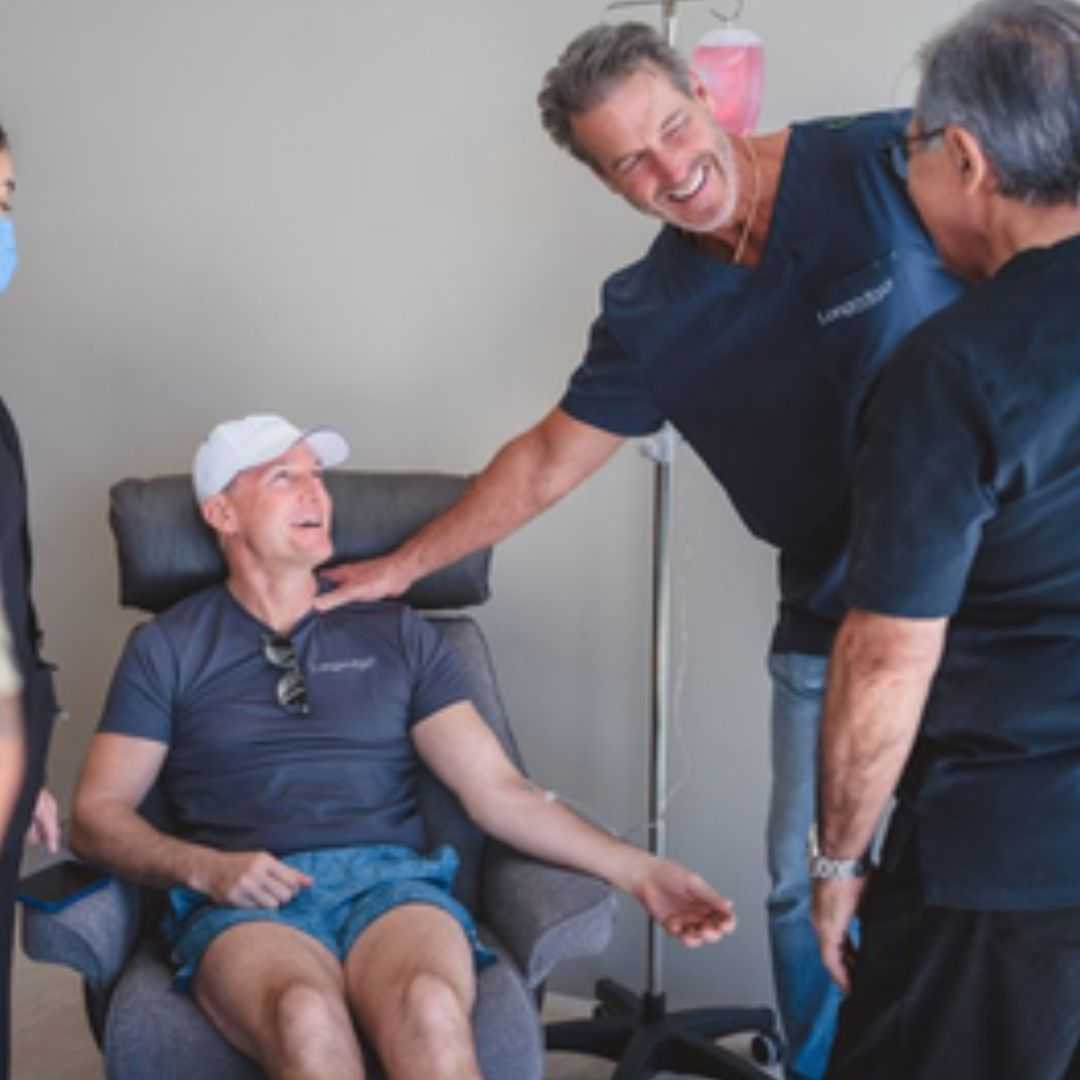
Unlock Your Body's Potential: Exploring Live Cell Therapy for Holistic Healing
Are you experiencing persistent fatigue, chronic pain, or a general decline in vitality that conventional treatments haven't fully addressed? Many individuals worldwide are seeking innovative solutions to restore their health and well-being. Live Cell Therapy, often grouped under the umbrella of regenerative medicine, offers a cutting-edge approach that harnesses your body's innate capacity for repair and renewal.
This therapy involves introducing healthy, specialized cells into the body to support organ function, modulate the immune system, and combat cellular aging. Unlike symptomatic treatments, Live Cell Therapy aims to address the root causes of many chronic conditions by promoting cellular regeneration and restoring physiological balance. Patients often search for "what is live cell therapy" or "live cell therapy benefits" to understand how it can help with everything from autoimmune disorders and degenerative diseases to anti-aging and overall revitalization.
For those looking for advanced treatments or more affordable options, exploring Live Cell Therapy abroad has become a compelling choice. Medical tourism destinations are increasingly offering sophisticated cellular therapies, often combining state-of-the-art medical facilities with a supportive environment for recovery. Whether you're grappling with the symptoms of chronic disease or simply seeking to enhance your quality of life, understanding Live Cell Therapy can open new avenues for your health journey.
What Are the Symptoms Live Cell Therapy Aims to Alleviate?
Patients considering Live Cell Therapy often present with a constellation of symptoms indicative of underlying cellular dysfunction, chronic inflammation, or age-related decline. These can significantly impact daily life and overall well-being. Common symptoms and conditions that Live Cell Therapy may target include:
- Chronic Fatigue and Low Energy: Persistent exhaustion not relieved by rest, often associated with conditions like Chronic Fatigue Syndrome or fibromyalgia. Many search for "live cell therapy for fatigue."
- Persistent Pain: Chronic joint pain, back pain, or widespread body aches, often linked to degenerative conditions like osteoarthritis or autoimmune diseases. Patients often look for "live cell therapy for joint pain."
- Reduced Organ Function: Decline in the performance of vital organs such as the liver, kidneys, or heart, impacting overall health and quality of life.
- Weakened Immune System: Frequent infections, slow healing, or autoimmune flares, signaling an imbalanced or underperforming immune response.
- Cognitive Decline: Issues with memory, concentration, and mental clarity that can accompany aging or certain neurological conditions.
- Signs of Premature Aging: Visible indicators like wrinkles, loss of skin elasticity, and a general lack of vibrancy, but also internal aging processes.
- Autoimmune Disorders: Conditions where the immune system attacks healthy tissues, such as Lupus, Rheumatoid Arthritis, or Multiple Sclerosis, where immune modulation is key.
The goal is not just to mask these symptoms but to support the body's intrinsic healing mechanisms at a cellular level, leading to a more holistic and sustainable improvement in health.
What Are the Underlying Causes and Risk Factors Addressed by Live Cell Therapy?
Many chronic health issues stem from a combination of factors that disrupt cellular health and system balance. Live Cell Therapy aims to intervene at these foundational levels. Key underlying causes and risk factors include:
- Cellular Damage & Dysfunction: Over time, cells accumulate damage from toxins, poor nutrition, and oxidative stress, leading to impaired function and premature cell death. This is often central to many "causes of chronic disease live cell therapy" addresses.
- Chronic Inflammation: A persistent inflammatory state can damage tissues and organs, contributing to autoimmune diseases, heart disease, and neurodegenerative conditions. Live Cell Therapy seeks to provide "inflammation treatment."
- Immune System Dysregulation: An overactive, underactive, or confused immune system can lead to autoimmune disorders, frequent infections, or an inability to fight off illness effectively.
- Age-Related Cellular Depletion: As we age, the number and vitality of our regenerative cells naturally decline, hindering the body's ability to repair itself. This is a primary target for "aging causes live cell therapy" aims to reverse.
- Environmental Toxins: Exposure to pollutants, heavy metals, and chemicals can overwhelm the body's detoxification pathways and damage cells.
- Poor Lifestyle Choices: Chronic stress, lack of sleep, sedentary habits, and an unhealthy diet contribute significantly to cellular degradation and systemic imbalance.
By introducing robust, healthy cells or cellular extracts, Live Cell Therapy provides the body with resources to combat these underlying issues, supporting regeneration, reducing inflammation, and harmonizing immune responses.
What Types of Live Cell Therapy Procedures Are Available?
The term "Live Cell Therapy" is broad and has evolved significantly. While historically it sometimes referred to "fresh cell therapy" derived from animal fetal tissues (which carries regulatory and ethical complexities in many regions), modern Live Cell Therapy often refers to a range of advanced regenerative treatments. When people search for "types of live cell therapy," they typically encounter:
- Stem Cell Therapy: This is perhaps the most widely recognized form of modern live cell therapy. It involves using undifferentiated cells that have the potential to develop into many different cell types and repair damaged tissues.
- Mesenchymal Stem Cells (MSCs): Often derived from umbilical cord tissue, adipose (fat) tissue, or bone marrow, MSCs are prized for their regenerative and anti-inflammatory properties, widely used for orthopedic, autoimmune, and anti-aging applications.
- Hematopoietic Stem Cells (HSCs): Primarily found in bone marrow and umbilical cord blood, HSCs are vital for regenerating blood and immune cells, crucial in treating certain blood disorders and immune deficiencies.
- Organ-Specific Cell Extracts: Some clinics utilize highly purified extracts from specific organs (e.g., liver, thymus) to support the function of the corresponding organ in the patient, promoting detoxification or immune balance.
- Exosome Therapy: Exosomes are tiny vesicles released by cells, containing proteins, lipids, and nucleic acids. They act as messengers, facilitating cell-to-cell communication and promoting healing and regeneration without containing live cells themselves.
- Immunomodulatory Cell Therapies: These therapies focus on balancing the immune system, particularly beneficial for autoimmune conditions, using various types of immune cells or their components.
The specific type of therapy chosen depends on the patient's condition, treatment goals, and the legal/ethical framework of the chosen medical destination. Many seek to understand "what is fetal cell therapy" as a historical reference, but modern applications are more often focused on stem cell derivatives and highly purified cell extracts.
Am I Eligible for Live Cell Therapy? Who Is It For?
Determining eligibility for Live Cell Therapy is a critical step and requires a thorough medical evaluation by a qualified specialist. When patients search for "who can get live cell therapy" or "live cell therapy age limit," they are looking for specific guidance. While criteria vary by clinic and the specific type of therapy, general considerations include:
- Chronic Degenerative Conditions: Individuals with conditions like osteoarthritis, Parkinson's disease, or chronic obstructive pulmonary disease (COPD) where tissue repair and regeneration are needed.
- Autoimmune Disorders: Patients suffering from conditions like rheumatoid arthritis, lupus, or multiple sclerosis, where immune modulation can significantly improve symptoms.
- Anti-Aging and Wellness: People seeking to counteract the effects of aging, boost vitality, improve skin health, or enhance overall physiological function.
- Good General Health: While treating chronic conditions, patients typically need to be in a stable enough state to undergo the procedure. Major acute illnesses or uncontrolled chronic diseases may be contraindications.
- Absence of Active Cancer: Most clinics will not treat patients with active cancer due to theoretical concerns about cell proliferation, although research in this area is ongoing. This falls under "live cell therapy contraindications."
- No Active Infections: Patients should be free from acute infections at the time of treatment to minimize risks.
- Realistic Expectations: Understanding that Live Cell Therapy is not a guaranteed cure but rather a modality to support the body's healing processes is crucial for patient satisfaction.
A comprehensive consultation, often involving medical records review and possibly diagnostic tests, will determine if you are a suitable candidate and which specific therapy is most appropriate for your needs.
What is the Recovery Time and What Can I Expect After Live Cell Therapy?
One of the appealing aspects of many Live Cell Therapy procedures is the relatively short "live cell therapy recovery" period. Unlike invasive surgeries, these treatments are often performed on an outpatient basis or with a short hospital stay, minimizing downtime. When considering "after live cell therapy what to expect," here's a general overview:
- Immediate Post-Procedure:
- Most patients can resume light activities within a day or two.
- You might experience mild soreness, bruising, or swelling at the injection sites, similar to any injection.
- Some individuals report temporary fatigue or flu-like symptoms for 24-48 hours as their body reacts to the cellular input.
- Short-Term (Days to Weeks):
- The immediate effects might not be dramatically noticeable, as the cells need time to integrate and begin their work.
- It's recommended to avoid strenuous activity for a few days to a week, depending on the specific therapy and injection sites.
- Clinics often provide specific post-treatment care instructions, including dietary advice and avoidance of certain medications.
- Long-Term (Weeks to Months):
- The full therapeutic benefits of Live Cell Therapy unfold gradually. Patients often inquire, "how long to see results live cell therapy?" It can take several weeks to many months to observe significant improvements as the new cells proliferate, differentiate, and modulate the body's systems.
- Improvements are typically progressive, with patients reporting enhanced energy, reduced pain, better organ function, and overall vitality over time.
- Follow-up appointments or telemedicine consultations are usually part of the care plan to monitor progress.
It’s important to maintain realistic expectations and understand that individual results can vary based on the specific condition, type of therapy, and the individual's response.
What Are the Risks and Side Effects of Live Cell Therapy?
Like any medical procedure, Live Cell Therapy carries potential risks and "live cell therapy side effects," though serious complications are rare, especially in reputable clinics. When asking "is live cell therapy safe" or expressing concerns about "live cell therapy dangers," it's crucial to consider the following:
- Common, Mild Side Effects:
- Injection Site Reactions: Tenderness, bruising, swelling, or minor pain at the site where cells are administered. These are typically temporary and resolve quickly.
- Temporary Flu-Like Symptoms: Some patients may experience mild fever, chills, fatigue, or headache for a day or two after treatment. This is often a sign of the immune system responding to the new cells.
- Rare, More Serious Risks:
- Infection: As with any procedure involving injections, there's a small risk of infection if sterile protocols are not rigorously followed. This risk is minimized in accredited medical facilities.
- Allergic Reaction: Though uncommon, an allergic reaction to the cellular material or other components used in the procedure can occur. Thorough patient screening helps to identify potential sensitivities.
- Immune Rejection: With allogeneic (donor) cells, there's a theoretical risk of immune rejection, though MSCs are generally considered immune-privileged, reducing this concern significantly.
- Unintended Cell Growth (Tumorigenicity): This is a frequently raised concern, but robust research and clinical practice, especially with properly sourced and characterized stem cells, show a very low risk of tumor formation. Reputable clinics use cells that have been tested and verified for safety.
To minimize risks, it is paramount to choose clinics with strong safety records, transparent practices, qualified medical professionals, and adherence to international guidelines for cell processing and administration.
How Much Does Live Cell Therapy Cost Worldwide? (Cost Comparison Table)
When patients search for "live cell therapy cost" or "how much does live cell therapy cost abroad," they quickly discover that prices are highly variable. Several factors influence the final cost:
- Type of Therapy: The specific cellular treatment (e.g., MSCs, exosomes, specific organ extracts) and the source of the cells.
- Dosage and Number of Treatments: More complex conditions may require higher cell counts or multiple treatment sessions.
- Clinic Reputation and Location: Premier clinics in high-cost-of-living areas naturally charge more.
- Inclusions: Some packages include consultations, diagnostics, post-treatment care, and even accommodation, while others are procedure-only.
- Country Regulations and Economic Factors: Different countries have varying regulatory landscapes and economic structures that impact pricing.
Here’s an estimated cost comparison for Live Cell Therapy across various regions, highlighting why medical tourism for "affordable live cell therapy" is appealing:
| Country/Region | Estimated Cost (USD) | Notes |
|---|---|---|
| USA | $15,000 - $50,000+ | Highly regulated, generally higher overheads, limited availability for certain therapies. |
| Western Europe (e.g., Germany, Switzerland) | $10,000 - $35,000 | Reputable clinics with strict quality controls, advanced research, but higher costs. |
| Mexico | $8,000 - $25,000 | Growing medical tourism hub, proximity to USA, often more affordable without compromising quality. |
| Thailand | $7,000 - $20,000 | Popular medical tourism destination with high-quality hospitals and competitive pricing. |
| Ukraine / Eastern Europe | $5,000 - $15,000 | Emerging options with lower costs, some clinics are pioneers in specific cell therapies. |
These figures are estimates and can vary widely based on the specific clinic, doctor's expertise, and the complexity of the patient's condition.
Why Consider Live Cell Therapy Abroad?
The decision to seek "live cell therapy medical tourism" or "why go abroad for live cell therapy" is driven by several compelling factors:
- Access to Advanced Therapies: Some cutting-edge Live Cell Therapies are only available or more widely practiced in certain countries due to varying regulatory environments. This allows patients to access treatments not yet approved or widely offered in their home country.
- Significant Cost Savings: As seen in the cost comparison, the price for Live Cell Therapy abroad can be considerably lower than in Western countries, making it a viable option for those without comprehensive insurance coverage for such treatments.
- Shorter Wait Times: In many countries, the healthcare system may have long waiting lists for specialized treatments. Traveling abroad can offer faster access to care.
- Specialized Expertise and Technology: Certain international clinics and doctors are pioneers in specific Live Cell Therapy techniques, offering world-class expertise and state-of-the-art facilities.
- Privacy and Discretion: Some patients prefer the anonymity and privacy offered by seeking medical treatment away from their local community.
- Combine Treatment with Travel: The opportunity to recover in a serene, beautiful environment and combine medical treatment with a "recovery vacation" is a significant draw. When searching for "best countries for live cell therapy," many envision a healing journey.
- Holistic Approach: Many international clinics, particularly in Asia, integrate Live Cell Therapy with holistic wellness programs, addressing not just the physical but also the mental and emotional aspects of healing.
These advantages make medical tourism an attractive pathway for many seeking Live Cell Therapy.
Which Countries Offer the Best Value and Quality for Live Cell Therapy?
When selecting a destination for Live Cell Therapy, patients often research "best live cell therapy clinics abroad." Several countries have emerged as leaders in combining high-quality care with reasonable costs:
- Mexico: A top choice for North Americans due to its proximity and significantly lower costs. Many clinics near the border or in major cities like Cancun, Guadalajara, and Tijuana offer advanced Live Cell Therapies with experienced doctors. "Live cell therapy in Mexico" is a popular search term.
- Thailand: Renowned for its excellent medical infrastructure, highly trained medical staff, and comprehensive patient services. Bangkok and other major cities boast internationally accredited hospitals that provide a range of cellular therapies, combined with world-class hospitality.
- Germany: Considered a pioneer in cellular medicine, Germany has a long history of research and stringent regulatory standards. While often at a higher price point than some Asian or Latin American options, it offers a high level of expertise and quality control, especially for "live cell therapy in Germany."
- Ukraine: Emerging as a notable destination, particularly for certain types of advanced cellular therapies. It offers a balance of cutting-edge treatments and more accessible pricing compared to Western Europe.
- Panama: Known for its progressive stance on regenerative medicine, Panama offers clinics that are at the forefront of stem cell research and application, attracting patients seeking innovative treatments.
When evaluating countries and clinics, always look for international accreditations (like JCI), transparent protocols, doctor qualifications, and positive patient testimonials to ensure both quality and safety.
What to Expect When Traveling for Live Cell Therapy Abroad?
Undertaking a medical journey abroad requires careful planning to ensure a smooth and stress-free experience. If you're searching for "medical travel for live cell therapy" or "planning live cell therapy abroad," here's what you can generally expect:
- Initial Consultation & Evaluation: This usually begins remotely. You'll share your medical history, diagnosis, and treatment goals. The clinic's specialists will review your case to determine eligibility and recommend a tailored treatment plan.
- Travel Logistics:
- Flights & Accommodation: You'll need to book your travel and lodging. Many clinics offer package deals or have partnerships with local hotels.
- Visa Requirements: Research the visa requirements for your chosen destination. Some countries offer medical visas.
- Transportation: Plan for local transport from the airport to your accommodation and to the clinic. Many clinics provide airport pickup and transportation services.
- Clinic Experience:
- International Patient Services: Most reputable clinics catering to medical tourists have dedicated international patient coordinators who assist with scheduling, logistics, language barriers, and all your needs.
- Pre-Treatment Assessments: Upon arrival, you'll undergo thorough in-person medical evaluations and diagnostic tests.
- The Procedure: Live Cell Therapy is typically performed as an outpatient procedure or with a short stay, depending on the specific treatment.
- Recovery & Aftercare:
- Post-Procedure Monitoring: You'll be monitored for a short period after the treatment.
- Follow-up Plan: Clinics provide detailed post-treatment care instructions, which may include medication, dietary advice, and lifestyle modifications. Remote follow-up is common.
- Enjoying Your Stay: Many patients use the recovery period to relax and experience the local culture, combining their healing journey with a restorative break. Think about "what to pack for live cell therapy trip" for comfort.
Engaging a medical tourism facilitator like PlacidWay can greatly simplify this process, handling many of these details for you.
How to Ensure Safety and Quality of Live Cell Therapy Abroad?
Ensuring "safe live cell therapy abroad" is paramount. With the growing popularity of medical tourism, it's crucial to exercise due diligence. Here’s how to navigate the landscape and choose a high-quality provider:
- Accreditation and Certification: Look for clinics with international accreditations like Joint Commission International (JCI). This signifies adherence to rigorous quality and safety standards. National accreditations are also important. When looking for "live cell therapy accreditation," JCI is a gold standard.
- Doctor Qualifications and Experience: Verify the credentials of the treating physicians. Are they board-certified in their specialty? Do they have extensive experience specifically in Live Cell Therapy? Ask about their success rates and training.
- Transparency in Cell Sourcing and Processing: Inquire about where the cells come from (autologous vs. allogeneic), how they are processed (e.g., in a GMP-certified lab), and if they undergo quality control and safety testing. Reputable clinics will be transparent about their protocols.
- Regulatory Compliance: Understand the local regulations governing Live Cell Therapy in your chosen country. Ensure the clinic operates legally and ethically within these guidelines.
- Patient Testimonials and Reviews: While not the sole factor, genuine patient success stories and reviews can offer insights into patient experience and outcomes. Look for consistent positive feedback.
- Comprehensive Consultation: A reputable clinic will conduct a thorough medical evaluation before recommending treatment, ensuring it's appropriate for your condition.
- Utilize Medical Tourism Facilitators: Companies like PlacidWay specialize in vetting international clinics and connecting patients with trusted providers. They can provide unbiased information, help you compare options, and advocate on your behalf, greatly reducing the risk involved in "how to choose live cell therapy clinic."
Don't hesitate to ask questions and seek clarification. Your health and safety are your top priorities.
What Are Patient Success Stories and Testimonials from Live Cell Therapy Abroad?
While individual results always vary, the appeal of Live Cell Therapy is significantly fueled by the numerous "live cell therapy testimonials" and "live cell therapy success stories" shared by patients who have sought treatment abroad. These stories often highlight transformative changes in their health and well-being:
- Chronic Pain Relief: Patients with severe joint degeneration or autoimmune conditions often report significant reduction in pain, improved mobility, and decreased reliance on pain medication. One patient with chronic knee pain, after receiving stem cell therapy in Mexico, reported being able to walk and cycle again without discomfort after years of limited movement.
- Boosted Energy and Vitality: Individuals suffering from chronic fatigue syndrome or age-related decline frequently share experiences of regained energy, mental clarity, and an overall sense of rejuvenation, often referring to a "new lease on life." Many of these narratives appear in "live cell therapy reviews abroad."
- Management of Autoimmune Symptoms: For those with conditions like lupus or MS, testimonials speak to a reduction in flare-ups, improved immune balance, and a slowed progression of their disease, allowing for better management of symptoms.
- Enhanced Organ Function: In some cases, patients with early-stage organ decline (e.g., liver or kidney issues) have reported improvements in functional markers and overall well-being after specialized cellular therapies.
- Improved Quality of Life: Beyond specific symptom relief, many patients emphasize a profound improvement in their overall quality of life, enabling them to return to hobbies, work, and social activities they had previously given up.
These stories serve as powerful testaments to the potential of Live Cell Therapy when performed by skilled professionals in well-equipped facilities. It's important to remember that such therapies are a journey, not a magic bullet, and outcomes depend on many factors unique to each individual.
Take the Next Step with PlacidWay
Ready to explore treatment options abroad? Discover top clinics, compare prices, and get a free quote tailored to your needs with PlacidWay.
Live Cell Therapy | Naturopathy | Ayurveda




-Package-in-Bangkok-Thailand-at-LRC-Fertility-Center.jpg)





Share this listing